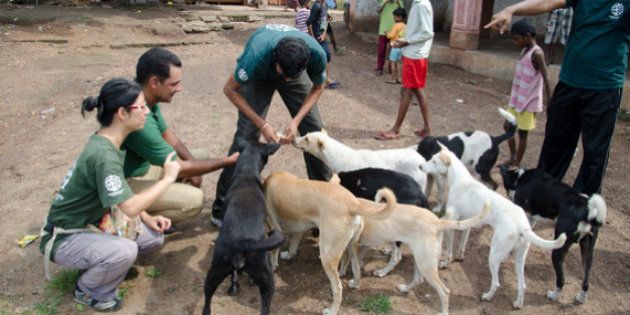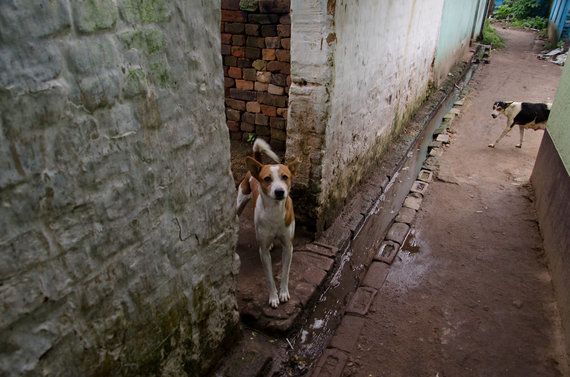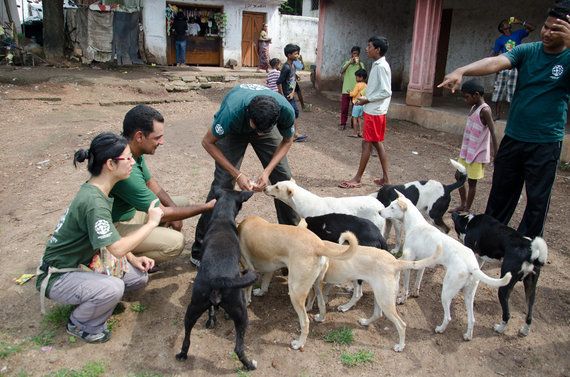

Photo Credit HSI
The media has recently been rife with sordid tales of torment inflicted upon animals by humans. While a man in Tamil Nadu was caught in the act of bestiality with a hapless cow, a widely circulated video depicted burning crackers tied to a terrified street dog's tail. In Pune, a group of children allegedly beat a dog to death and hung the body on a tree while a dog fighting nexus was revealed in India's capital.
Any act that tortures or causes suffering and/or pain to any animal qualifies as animal abuse. Such acts range from a failure to provide food and water (neglect) to open violence like kicking, beating and poisoning that are intended to cause physical harm, pain and even death. Immanuel Kant philosophised centuries ago, "He who is cruel to animals becomes hard also in his dealings with men. We can judge the heart of a man by his treatment of animals." Today, science has provided substantial evidence supporting Kant's perspective. Human beings who indulge in animal abuse, especially sadistic animal abuse, are likely to have a substantial tendency for violence towards fellow human beings.
"[V]iolent individuals may hide their behaviour towards humans but are less likely to conceal cruelty to animals..."
In 1987, the third edition of the Diagnostic and Statistical Manual of Mental Disorders incorporated animal cruelty as a diagnostic criterion for Conduct Disorder and Antisocial Personality Disorder. The inclusion of animal cruelty as a diagnostic indication is the result of research confirming the association of such behaviour with violence to humans. InUnderstanding the Link between Violence to Animals and People: A Guidebook for Criminal Justice Professionals, author Allie Phillips suggests that the presence of animal cruelty is an indicator of the occurrence of two or more types of "intra-familial abuse" which include various forms of child abuse, domestic violence, elder abuse and animal abuse.
A study by F R Ascione, discusses 12 independent studies which revealed that up to half of battered women stayed with their abuser because they feared for the well being of their animals. In abusive environments, relationships with animals may be a crucial source of support, companionship and even serve as a form of refuge against violence. Hence, abusers view these companion animals as their victims' Achilles heels and threaten or mistreat them to ensure that the victim complies with their demands, which range from acquiescence in crimes, refusal to end unhealthy relationships or even silence regarding the victims' own abuse. Injury to or separation from these pets may also be intended as a form of psychological punishment to the victim.
At the same time, exposure to such extreme acts of violence can also damage a child's sense of empathy which predisposes violent behaviour in the future. A publication by the National Link Coalition refers to the link between animal cruelty and other forms of abuse. In it, Dr Barbara Boat suggests that exposure to animal abuse at a young age affects the development of the brain resulting in "long term hyper response to perceived threats" which affects physical and psychological development.

Photo Credit HSI
Animal abuse often goes unreported, owing to threats of harm by the perpetrators as well as due to indifference from the public and the authorities. However, as has been proven time and again, acts of animal abuse are a very important indicator of a potential to indulge in other dangerous forms of violence. In addition, violent individuals may hide their behaviour towards humans but are less likely to conceal cruelty to animals ("it is only a dog"). Condoning or ignoring such acts helps perpetuate an environment where violence towards fellow beings is no longer considered aberrant behaviour. Stemming the rot of animal abuse requires public awareness of the link between various forms of abuse as well as collaboration between animal welfare organisations, veterinarians and the police. Disclosure of incidences of abuse must be encouraged with greater protection for whistle blowers. Meanwhile, laws relating to abuse and violence must take into cognizance the safety and protection of pets.
Animal abuse is often justified as a means to quell the "beast". It's time we questioned if the beast is within or without.